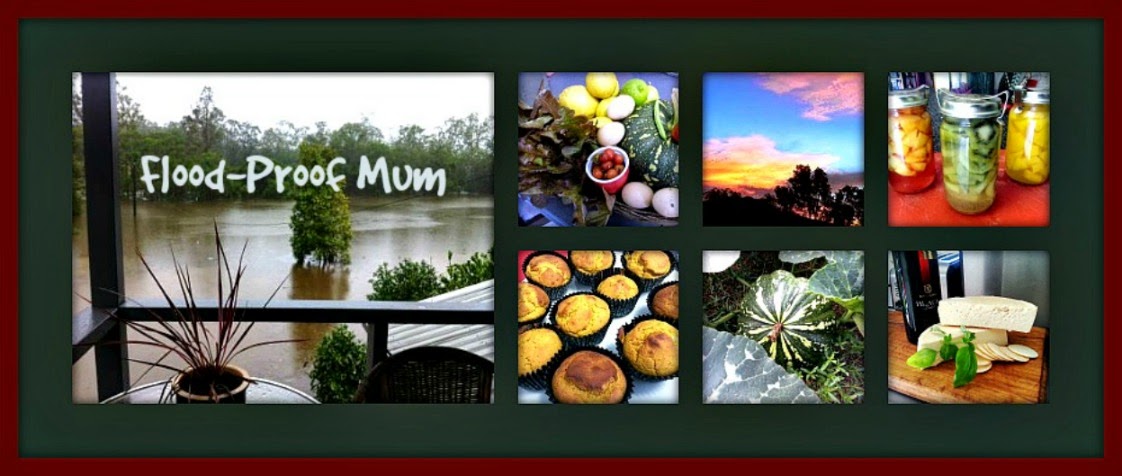Even if you don't flood the situation in NSW at the moment with the bushfires, has made the world aware that you never know when a disaster is likely to occur...and we should all plan for that eventuality. My home town of Gympie is pretty famous for its resilience and ability to bounce back after a big flood. That is because we are organised, plan ahead, and know what to expect after many years of floods. The same situation applies at my place.
 |
| View from the dinghy as we evacuated |
We stayed at our property until it seemed likely that the top floor would also be flooded (thank God this did not occur). We moved everything up as high as we could and packed essential food supplies and a few clothes. Because we were caught unawares our emergency pack was not stocked and ready to go. Exhausted, we rowed our dinghy to our neighbours property where we were later airlifted into Gympie. Our neighbour was rescued from the roof of her house where she sat with her husband and two dogs. One of the dogs blew into the water when the helicopter arrived and was later found. Emergency services will not take your pets which is heartbreaking.
 |
| We finally reached some shallow water |
 |
| My boys loved the helicopter ride |
There are many fact sheets under the tab of Get Prepared and I encourage you to have a look at them: This is a small summary from the Emergency Kit Fact Sheet:
QUEENSLAND Emergency kit: essential items, all times 3
Prepare your household
with all 7 fact sheets:
1 Prepare Emergency Plan
2 Prepare for evacuation
3 Prepare Emergency Kit
4 Prepare your home
5 Tune into warnings!
6 Check your neighbours
7 Pet Emergency Plan
Always remember:
Having an Emergency Kit is an important step to prepare for, survive and cope with emergencies.
Know:
All householders need to know where your Emergency Kit is kept.
Check:
and update the contents of your kit regularly, to ensure everything is in working order and has not expired.
Discuss:
your Emergency Kit with all householders and make sure everyone knows what to do in an emergency.
This is a list of items which should be in your kit at all times:
Food and water
Range of non-perishable food items
Bottled water
Medical and sanitation
First Aid Kit and manual
Essential medications, prescriptions
and dosage
Toilet paper
Toothbrush/toothpaste
Soap/shampoo
Personal hygiene items
Light
Flashlight/torch with extra batteries
Battery powered lantern
Communications
Battery powered radio with extra batteries
Traditional wired telephone
Prepaid phone cards and coins for phone calls
Clothing and footwear
Warm jumper, waterproof jacket, hat
and gloves for everyone
Closed-toed shoes or boots for everyone
Tools and supplies
Whistle, utility knife, duct/masking tape
Plastic garbage bags, ties
Safety Glasses and sun glasses
Miscellaneous
Special Items for Infants
(nappies, formula etc)
Special items needed by elderly
or people with special needs
Spare house and car keys
Pet food, water and other animal needs
Important documents: Keep original or certified copies of these documents in your Emergency Kit. Scan copies of them and save the files on a USB memory stick or CD to include in your kit. Keep all these items in sealed plastic bags:
Insurance papers for your house and contents, cars, and for valuable items
Inventory of valuable household goods
Wills and life insurance documents
House deeds/mortgage documents
Birth and marriage certificates
Passports/visa details
Stocks and bonds
Medicare, pension cards,
immunisation records
Bank account and credit card details
A back-up copy of important computer files
Household Emergency Plan with emergency
contact numbers (also see Fact Sheet 1) getready
QUEENSLAND
This information is included on the first page of the fact sheet, and the second page covers extra items you should have. Some of this may seem like common knowledge but we have lost photographs, birth certificates, legal documents, personal letters and mementos in the first floods when we did not know what to expect...that's another story for another day. I now keep passports and birth certificates in a safe at work which will never flood. I would add to the above list your mobile phone charger as you will have many phone calls to make during and after an emergency. You may not have access to electricity straight away, but when you do there is so much to organise, and people to notify.
I pray for those who have lost their homes and belongings in the recent bushfires. I am thankful that my house is still here to come home to, and can only imagine what it must feel like to not have that. Although some material possessions can be replaced, there would be many who have lost precious mementos and that takes some time to accept. My prayers are with you all. If you come through it without loss of life, that is the greatest blessing. I count mine every time.
I hope you have found this information useful and will prepare your emergency pack...just in case.
Do you have one already? Have you had an emergency situation before?




